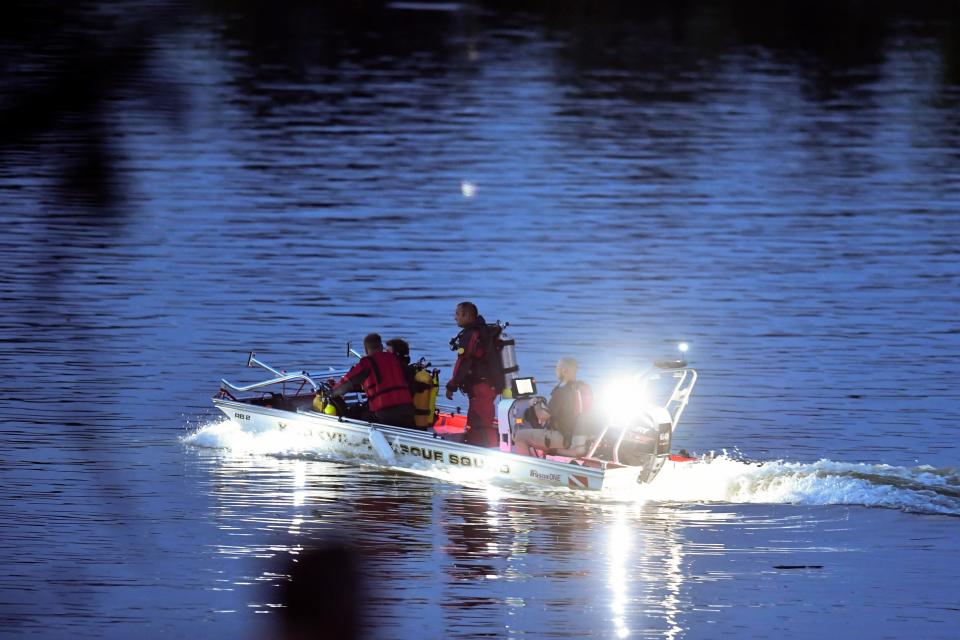How old is too old to pilot a helicopter? Jim Clayton's fatal crash puts spotlight on age
Everybody ages differently, and there's no golden rule for when a person should give up tasks they handled easily when they were younger. But when it comes to flying helicopters, 86 years old is "well beyond" the age a pilot should think about letting someone else do the flying, said Peter Goelz, former managing director of the National Transportation Safety Board.
Goelz spoke with Knox News in the weeks following the August 2020 crash of a helicopter piloted by Clayton Homes founder Jim Clayton, who was 86 at the time. The crash into the Tennessee River killed Clayton's brother, Joe, 84, who drowned when he couldn't escape the aircraft. Goelz, who was not working for the NTSB when Knox News spoke to him, questioned whether Jim Clayton should have been in the cockpit when he crashed the Eurocopter EC130.
Joe Clayton: Family overwhelmed by tragic death and 'outpouring of love'
"It's simply a matter of fact that your flying skills diminish the older you get," Goelz told Knox News. "And flying a sophisticated piece of equipment like the Eurocopter takes some genuine skill. At some point, a responsible pilot has to say, 'You know, I just shouldn’t do this anymore.'"
Jim Clayton, now 88 years old, survived the crash, along with two passengers.
The NTSB has since found Jim Clayton was at fault in the crash, according to a final report released by the agency Tuesday. The agency says Jim Clayton's flying created an aerodynamic phenomenon known as vortex ring state, and led to the crash when combined with his "inability to arrest the helicopter's descent while maneuvering for landing."
Jim had five hours of flight time in the previous 90 days leading up to the crash, according to the report, and only two of those hours took place in a helicopter. He no longer has privileges to pilot a helicopter, though it's not clear whether those privileges were revoked or given up voluntarily.
Still, Jim was able to pilot an airplane until his updated medical certification expired in May 2021, according to a Federal Aviation Administration database. Jim could fly airplanes again if his medical certification is renewed.
Smokies helicopter crash: Pilot was not supposed to fly. So, how did he get in the air?
Knox News reached out to a spokesperson for an interview with Jim, but our request was denied with the following statement: "The family is reviewing the NTSB report and has no comment at the present time."

THE LATEST NEWS RIGHT AT YOUR FINGERTIPS
Get the latest local news, sports scores and more directly on your phone. Download the free Knox News mobile app.
Helicopters more complex than planes
Goelz said many private pilots believe they should keep their licenses until they fail a medical check, but others question the stringency of those exams.
Dr. James Powers, a geriatrician at Vanderbilt University Medical Center, previously told Knox News it’s important to draw a distinction between a person’s physical age and their physiological age.

“This is the first time in the course of human history that we’ve had so many people live to reach the age of 100,” he told Knox News in the month after Clayton's crash. “We are seeing more people live out to extreme old age.”
But once a person turns 75 or 80 years old, Powers said, “we start to question the necessity of certain things that maybe aren’t that critical.”
Goelz, who was 72 at the time of the interview, told Knox News he is worse at driving a car now than when he was 40 – “that’s just the simple truth." Drivers 70 and older have a higher fatal crash rate per mile compared to middle-aged drivers, according to the Insurance Institute for Highway Safety.
But driving a car is easier for most people than flying a plane. And piloting a helicopter is more difficult than both, said Robert Katz, a commercial airplane pilot and flight instructor who frequently speaks with news outlets following aircraft crashes.
Helicopters take two feet and two hands to operate the controls, Katz said. Two sticks have to be manipulated in unison, while an airplane takes just one hand to maneuver flight controls.
“All helicopters are going to fundamentally operate the same way, but the heavier the helicopter is, the more sensitive it’s going to be to control the inputs,” Katz told Knox News. "And since it’s really a delicate balancing act, the performance of the helicopter to get it to do what you want to do is going to be a reflection of the pilot’s skill and ability to make it happen.”
While there’s no rule against pilots flying helicopters in their 80s (as long as they pass a medical exam), airline pilots in the United States have a forced retirement age of 65.
The average age of a private pilot in 2019 was 48.3 years old, while just about 1.8% of all active private pilots in December 2019 were at least 80 years old. Both of these stats take into account all types of aircrafts, according to data gathered by the General Aviation Manufacturers Association.
Crash details revealed in NTSB report
The Aircraft Owners and Pilots Association explains vortex ring state can happen when "a helicopter descends at a rate that puts the blades in their own downwash."
"Instead of drawing clean air from above the blades, some disturbed air begins to travel up through the blades," according to the Aircraft Owners and Pilot Association.
In Jim's case, he created the vortex ring state when he "descended steeply with little forward airspeed" and then applied power to stop the descent, the report states.
Katz, who is based in Dallas and has more than 40 years of experience, previously reviewed the preliminary NTSB report at the request of Knox News. Emphasizing he was using only the information he gleaned from the report, Katz shared his analysis.
"When (vortex ring state) happens, the helicopter will not have enough power to overcome this vicious cycle, and the helicopter will then settle from its current position to a lower altitude – in this case, into the river," Katz said.
Statements provided to NTSB by Jim and his grandson Flynt Griffin, who was on board during the crash, shed light on what happened during the flight.
Jim told NTSB the flight was all about enjoying some scenery and photographing properties owned by people on board. The helicopter stopped at McGhee Tyson Airport roughly 90 minutes before the crash on Aug. 3, 2020, for 100 gallons of fuel.
Griffin, who has been flying with his grandfather since he was a child, said Jim always informs passengers of safety protocols and that "everything felt very normal" as the helicopter approached the landing area on Jim's property in Sequoyah Hills just before 7:45 p.m.
There was "no warning," Griffin told NTSB. All but two feet of the cabin was filled with water immediately after crashing into the river, according to Griffin, who took a breath from the air bubble above him and swam between the front seats.
Griffin helped passenger John McBride get free but could not find anyone else. Jim later popped out of the water on his own, according to Griffin's account in the NTSB report.
Katz told Knox News he does not pilot helicopters, but vortex ring state is common knowledge in the piloting world.
"It is something that all helicopter pilots would be trained to recognize and also trained to mitigate with an appropriate action as to fly out of the area of disturbed air," he said.

Jim's statement also revealed Joe took over the controls for about 20 minutes during the flight but was not in control in the moments leading up to the crash. While Joe had a pilot's license, he was not certified to fly helicopters.
The NTSB report says the crash might have been prevented "by choosing a better equipped landing site with a more simplistic approach."
Additionally, inflatable restraints were not installed on the helicopter, according to the report.
Senses, reaction times decline with age
Powers said senses and reaction times are two important factors when it comes to operating machinery, and both decline with old age.
An FAA pilot database shows Jim no longer has the helicopter privileges that allowed him to fly in August 2020. He still needs hearing amplification while flying, which was required at the time of the crash.
Goelz said hearing is “one of the basic senses that human beings are blessed with,” and it’s a necessary sense for operating a helicopter. For example, hearing allows pilots to listen to the pitch of an engine for indications something is wrong.
Katz said pilots typically wear headphones while flying to communicate with air traffic control.
In recordings obtained by Knox News, Jim can be heard asking air traffic control to repeat his squawk number, which is used to identify aircraft as they travel. He also mistakes air traffic instructions to make a left turn for a right turn and, when corrected by the controller, still mishears the angle of the turn.
“(Hearing is) an absolute essential sense that simply has to be checked off as adequate,” Goelz said, referring to the physical exams required of pilots. “If they’re administered by the book, they’re just fine. But that’s a big ‘if.’"
The older you get, there's no 'reserve'
Jim Clayton was given "special issuance" medical certification after being examined by his personal physician, Dr. James Hurst, according to NTSB documents. Typically, special issuance certifications expire after one year.
At the time of the crash, an FAA airman database showed Jim's medical certification had expired. However, FAA spokesperson Kathleen Bergen told Knox News in the days following the crash that the FAA's public database simply had not been updated and that Clayton had recertified his medical requirements.
However, NTSB's final report shows the date of Jim's last medical certification at the time of the crash was May 4, 2019, or 15 months prior. When asked about the discrepancy, an FAA spokesperson told Knox News to refer to NTSB documents.
Powers administers FAA physicals and was surprised an 86-year-old person could pass. The exams are strict and require laboratory testing and mental exams but, as Powers also said, physical age and physiological age are two different measures.
Experience is one category in which an older person has an advantage, but it can be overshadowed by a decline in reaction times.
“There’s always risks involved in a high-performance job like flying or operating a crane,” Powers said. “But the older you get, despite physical state, there’s not that reserve. If something happens – whether something changes, the engine stalls – you have to react.”
Instagram | Email | 865-317-5138 | Unlock premium perks and support stong local journalism at knoxnews.com/subscribe.
This article originally appeared on Knoxville News Sentinel: Jim Clayton helicopter crash in Knoxville draws concern over pilot age

